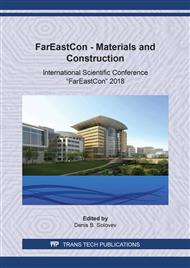[1]
A.M. Isonkin, R.K. Bogdanov, Vliyanie metallizatsii almazov na pokazateli rabotosposobnosti burovykh koronok [Effect of diamond metallization on the performance of drilling bits], Naukovi pratsi DonNTU. Seriya «Girnicho-geologichna». 181 (2011) 158–163.
Google Scholar
[2]
M. Zeren, S. Karagöz, Sintering of polycrystalline diamond cutting tools, Materials and Design. 28 (2007) 1055–1058.
DOI: 10.1016/j.matdes.2005.09.018
Google Scholar
[3]
W. Tillmann, M. Tolan, N.F. Lopes-Dias, M. Zimpel, M. Ferreira, M. Paulus, Influence of chromium as carbide forming doping element on the diamond retention in diamond tools, International Conference on Stone and Concrete Machining (ICSCM). 3 (2015) 21–30.
Google Scholar
[4]
V.A. Konovalov, V.N. Tkach, V.V. Shatohin, Razrushenie metallicheskoj svjazki pri vysokoskorostnom ciklicheskom nagruzhenii almaznogo zerna. Porodorazrushajushhij i metallobrabatyvajushhij instrument – tehnika i tehnologija ego izgotovlenija i primenenija [Destruction of the metal bundle during high-speed cyclic loading of diamond grain. Pulverizing and metalworking tools - technique and technology for its manufacture and application], Sb. nauchnyh trudov ISM im. V. N. Bakulja NAN Ukrainy. 12 (2009) 504–508.
Google Scholar
[5]
P.P. Sharin, S.P. Yakovleva, V.E. Gogolev, M.I. Vasil'eva, Strukturnaya organizaciya vysokoiznosostojkih almazosoderzhashchih kompozitov na osnove tverdosplavnyh poroshkov, poluchennyh metodom spekaniya s propitkoj med'yu [Structural organization of highly wear-resistant diamond-containing composites based on carbide powders obtained by sintering with copper impregnation]. Perspektivnye materialy. 6 (2015) 66–77.
Google Scholar
[6]
Schubert T., Trindade B., Weißgärber T., Kieback B. Interfacial design of Cu-based composites prepared by powder metallurgy for heat sink applications // Materials Science and Engineering. 2008. V. 475, №1–2. P. 39–44.
DOI: 10.1016/j.msea.2006.12.146
Google Scholar
[7]
D.-P. Margaritis, Interfacial bonding in metal-matrix composites reinforced with metal-coated diamonds, PhD thesis, University of Nottingham, 2003, 345 p.
Google Scholar
[8]
W. Tillmann, M. Ferreira, A. Steffen, K. Rüster, J. Möller, S. Bieder, M. Paulus, M. Tolan, Carbon reactivity of binder metals in diamond-metal composites –characterization by scanning electron microscopy and X-ray diffraction, Diamond and Related Materials. 38 (2013) 118-123.
DOI: 10.1016/j.diamond.2013.07.002
Google Scholar
[9]
D.A. Sidorenko, E.A. Levashov, P.A. Loginov, N.V. Shvyndina, E.A. Skryleva, I.E. Uskova, O mekhanizme samoproizvol'nogo plakirovaniya almaza karbidom vol'frama v processe spekaniya instrumenta s nanomodificirovannoj metallicheskoj svyazkoj Su–Fe–Co–Ni [Mechanism of spontaneous diamond plating with tungsten carbide during the sintering of a tool with nanomodified Cu-Fe-Co-Ni metal bond]. Izvestiya vuzov. Cvetnaya metallurgiya. 5 (2015) 53–63.
DOI: 10.17073/0021-3438-2015-5-53-63
Google Scholar
[10]
Tillmann W., C. Kronholz, M. Ferreira, A. Knote, W. Theisen, P. Schütte, J. Schmidt, Diamond-metal-matrix interaction in diamond tools, fabricated by conventional and current induced short-time sintering processes, International Journal of Powder Metallurgy. 47 (2011) 29-36.
Google Scholar
[11]
M. Uemura, An analysis of the catalysis of Fe, Ni or Co on the wear of diamonds, Tribology International. 37 (2004) 887-892.
DOI: 10.1016/j.triboint.2004.07.004
Google Scholar
[12]
C.M. Sung, M.F. Tai, Reactivities of transition metals with carbon: Implications to the mechanism of diamond synthesis under high pressure, Intern. Jour. of Refractory Metals & Hard Materials. 15 (1997) 237-256.
DOI: 10.1016/s0263-4368(97)00003-6
Google Scholar
[13]
W.S. Li, J. Zhang, H. Dong, K. Chu, S. Wang, Y. Liu, Y. Li, Thermodynamic and kinetic study on interfacial reaction and diamond graphitization of Cu-Fe-based diamond composite, Chinese Physics B. 22 (2013) 18102.
DOI: 10.1088/1674-1056/22/1/018102
Google Scholar
[14]
A. Romansky, Factors affecting diamond retention in powder metallurgy diamond tools, Archives of metallurgy and materials.55 (2010) 1073–1081.
DOI: 10.2478/v10172-010-0009-1
Google Scholar
[15]
V.A. Loktyushin, L.M. Gurevich, Poluchenie nanotolshchinnyh metallicheskih pokrytij na sverhtverdyh materialah metodom termodiffuzionnoj metallizacii [Obtaining nano-thick metal coatings on superhard materials by thermal diffusion metallization]. Izvestiya Volzhskogo gosudarstvennogo tekhnicheskogo universiteta. 11 (2009) 50–54.
Google Scholar
[16]
M.M. Yakhutlov, B.S. Karamurzov, Z.Zh. Berov, U.D. Batyrov, R.M. Nartyzhev, Napravlennoe formirovanie mezhfaznoj granicy almaz-matrica s ispol'zovaniem nanopokrytij [Directional formation of the interface boundary of a diamond-matrix using nanocoatings]. Izv. Kabardino-Balkarskogo gosuniversiteta. 1 (2011) 23–25.
Google Scholar
[17]
Y.Z. Hsieh, J.F. Chen, S.T. Lin, Pressureless sintering of metal-bonded diamond particle composite blocks, Journal of materials science. 35 (2000) 5383-5387.
Google Scholar
[18]
N.V. Tsypin, E.S. Simkin, G.D. Kostenetskaya, Metallograficheskoe issledovanie vzaimodeistviya almazov s metallami pri vysokikh temperaturakh [Metallographic study of diamonds interaction with metals at high temperatures], Adgeziya i paika materialov. 4 (1979) 78–80.
Google Scholar
[19]
P.P. Sharin, M.P. Lebedev, V.E. Gogolev, R.G. Nogovitsyn, P.A. Slobodchikov, Patent RU 2478455 (2013).
Google Scholar
[20]
A. Peterson, J. Agren, Sintering shrinkage of WC-Co materials with bimodal grain size distribution, Acta Materialia, 53 (2005) 1665–1671.
DOI: 10.1016/j.actamat.2004.12.016
Google Scholar


